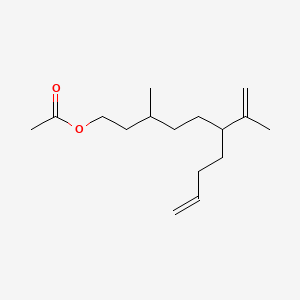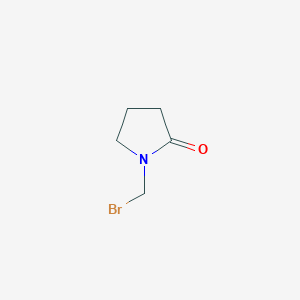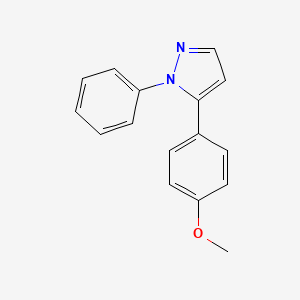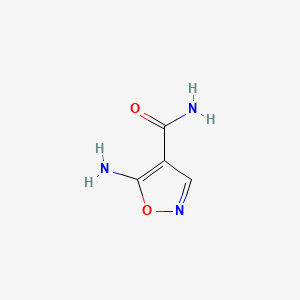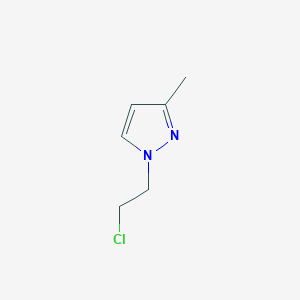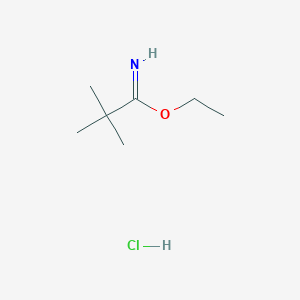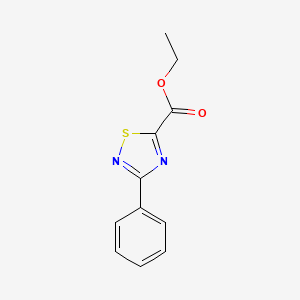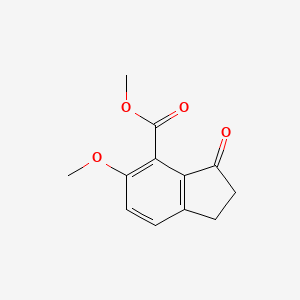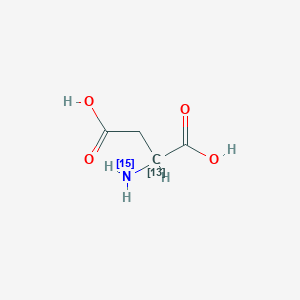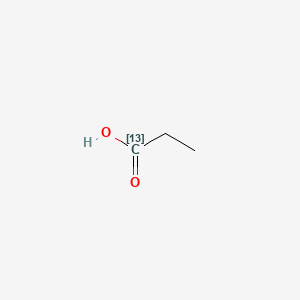
(113C)propanoic acid
Overview
Description
(113C)propanoic acid: is a stable isotope-labeled compound of propanoic acid, where the carbon-13 isotope is incorporated at the first carbon position. This compound is often used in scientific research, particularly in the fields of chemistry and biochemistry, due to its unique isotopic labeling which allows for detailed tracking and analysis in various experimental setups .
Scientific Research Applications
(113C)propanoic acid has a wide range of applications in scientific research:
Mechanism of Action
Target of Action
Propanoic acid-1-13C, also known as (113C)propanoic acid, is a variant of propionic acid where one of the carbon atoms is the isotope Carbon-13 . Propionic acid is an antimicrobial food additive . It acts as an antimicrobial agent for food preservation and flavoring agent .
Mode of Action
The mode of action of Propanoic acid-1-13C is similar to that of propionic acid. As a naturally occurring carboxylic acid, propionic acid typically undergoes metabolism via conversion to propionyl coenzyme A (propionyl-CoA), which is part of the usual metabolic pathway that carboxylic acids participate within in the human body .
Biochemical Pathways
Propionate can be produced via various metabolic pathways, which can be classified into three major groups: fermentative pathways, biosynthetic pathways, and amino acid catabolic pathways . The primary fermentation pathways catabolize different carbon sources to propionate and include the well-known acrylate and Wood-Werkman cycle pathways of native propionate producers .
Result of Action
The result of propionic acid’s action is primarily its antimicrobial and preservative activities. These activities stem from its metabolic pathway as the metabolic fate of propionates varies in different microorganisms, resulting in antimicrobial mechanisms of action that may revolve around differing propionate metabolites causing competition, inhibition, and/or interference .
Safety and Hazards
Propanoic acid-1-13C is considered hazardous. It can cause skin and eye irritation upon contact, and its inhalation can lead to respiratory discomfort . It is flammable and may be corrosive to metals . Adequate ventilation, protective clothing, and safety goggles are among the measures to minimize risks associated with propanoic acid in industrial settings .
Biochemical Analysis
Biochemical Properties
Propanoic acid-1-13C participates in various biochemical reactions. It is a weak acid and does not completely ionize in water . It reacts with metals to form hydrogen gas and metal carboxylate salts . It also reacts with alcohols to form esters . The isotopic purity of Propanoic acid-1-13C is 99 atom % 13C .
Cellular Effects
Propanoic acid-1-13C has significant effects on various types of cells and cellular processes. It disrupts endocytosis, cell cycle, and cellular respiration in yeast cells . It causes a dramatic increase in the uptake of lucifer yellow in yeast cells, which is consistent with enhanced endocytosis . It also causes a significant increase in the proportion of yeast cells in G1 and a significant decrease in the proportion of cells in G2, suggesting that it causes a cell cycle arrest in yeast .
Molecular Mechanism
The molecular mechanism of Propanoic acid-1-13C involves its conversion to propionyl coenzyme A (propionyl-CoA), which is part of the usual metabolic pathway that carboxylic acids participate within in the human body . It can directly enter either beta oxidation or the citric acid cycles .
Temporal Effects in Laboratory Settings
It is known that it has a half-life of about 6.9 +/- 0.4 minutes in the sheep animal model .
Dosage Effects in Animal Models
The effects of Propanoic acid-1-13C vary with different dosages in animal models. For instance, in a rodent model of Autism Spectrum Disorders (ASD), intracerebroventricular (ICV) injections of Propanoic acid-1-13C were found to induce numerous behavioral, electrophysiological, and neuropathological changes in rats that are consistent with those observed in ASD .
Metabolic Pathways
Propanoic acid-1-13C is involved in various metabolic pathways. It can be produced via fermentative pathways, biosynthetic pathways, and amino acid catabolic pathways . It is first converted to propionyl coenzyme A (propionyl-CoA), which can directly enter either beta oxidation or the citric acid cycles .
Transport and Distribution
It is known that it is a liquid at room temperature and has a density of 0.993 g/mL at 25 °C .
Subcellular Localization
It is known that it can readily gain access to the brain, where it can induce a diverse range of neurophysiological processes capable of altering both brain function and behavior .
Preparation Methods
Synthetic Routes and Reaction Conditions: (113C)propanoic acid can be synthesized through isotope exchange reactions. One common method involves reacting propanoic acid with a reagent containing the carbon-13 isotope under appropriate conditions to facilitate the exchange of isotopes . Another synthetic route involves the reaction of carbon-13 dioxide with ethylmagnesium bromide .
Industrial Production Methods: Industrial production of propanoic acid-1-13C typically involves large-scale isotope exchange reactions, ensuring high isotopic purity and yield. The process is carefully controlled to maintain the integrity of the carbon-13 isotope and to produce the compound in sufficient quantities for research and commercial use .
Chemical Reactions Analysis
Types of Reactions: (113C)propanoic acid undergoes various chemical reactions, including:
Oxidation: Propanoic acid can be oxidized to produce carbon dioxide and water.
Reduction: It can be reduced to form propanol.
Substitution: The carboxyl group can be substituted with other functional groups under specific conditions.
Common Reagents and Conditions:
Oxidation: Common oxidizing agents include potassium permanganate and chromium trioxide.
Reduction: Reducing agents such as lithium aluminum hydride or sodium borohydride are used.
Substitution: Reagents like thionyl chloride or phosphorus tribromide can facilitate substitution reactions.
Major Products:
Oxidation: Carbon dioxide and water.
Reduction: Propanol.
Substitution: Various substituted propanoic acid derivatives depending on the reagent used.
Comparison with Similar Compounds
Propionic acid-13C3: Contains three carbon-13 isotopes.
Sodium propionate-1-13C: The sodium salt form of propanoic acid-1-13C.
Acetic acid-13C2: Contains two carbon-13 isotopes.
Uniqueness: (113C)propanoic acid is unique due to its specific labeling at the first carbon position, which provides distinct advantages in tracking and analyzing metabolic and chemical processes.
Properties
IUPAC Name |
(113C)propanoic acid | |
|---|---|---|
| Source | PubChem | |
| URL | https://pubchem.ncbi.nlm.nih.gov | |
| Description | Data deposited in or computed by PubChem | |
InChI |
InChI=1S/C3H6O2/c1-2-3(4)5/h2H2,1H3,(H,4,5)/i3+1 | |
| Source | PubChem | |
| URL | https://pubchem.ncbi.nlm.nih.gov | |
| Description | Data deposited in or computed by PubChem | |
InChI Key |
XBDQKXXYIPTUBI-LBPDFUHNSA-N | |
| Source | PubChem | |
| URL | https://pubchem.ncbi.nlm.nih.gov | |
| Description | Data deposited in or computed by PubChem | |
Canonical SMILES |
CCC(=O)O | |
| Source | PubChem | |
| URL | https://pubchem.ncbi.nlm.nih.gov | |
| Description | Data deposited in or computed by PubChem | |
Isomeric SMILES |
CC[13C](=O)O | |
| Source | PubChem | |
| URL | https://pubchem.ncbi.nlm.nih.gov | |
| Description | Data deposited in or computed by PubChem | |
Molecular Formula |
C3H6O2 | |
| Source | PubChem | |
| URL | https://pubchem.ncbi.nlm.nih.gov | |
| Description | Data deposited in or computed by PubChem | |
DSSTOX Substance ID |
DTXSID00480909 | |
| Record name | Propanoic acid-1-13C | |
| Source | EPA DSSTox | |
| URL | https://comptox.epa.gov/dashboard/DTXSID00480909 | |
| Description | DSSTox provides a high quality public chemistry resource for supporting improved predictive toxicology. | |
Molecular Weight |
75.07 g/mol | |
| Source | PubChem | |
| URL | https://pubchem.ncbi.nlm.nih.gov | |
| Description | Data deposited in or computed by PubChem | |
CAS No. |
6212-69-7 | |
| Record name | Propanoic acid-1-13C | |
| Source | EPA DSSTox | |
| URL | https://comptox.epa.gov/dashboard/DTXSID00480909 | |
| Description | DSSTox provides a high quality public chemistry resource for supporting improved predictive toxicology. | |
| Record name | 6212-69-7 | |
| Source | European Chemicals Agency (ECHA) | |
| URL | https://echa.europa.eu/information-on-chemicals | |
| Description | The European Chemicals Agency (ECHA) is an agency of the European Union which is the driving force among regulatory authorities in implementing the EU's groundbreaking chemicals legislation for the benefit of human health and the environment as well as for innovation and competitiveness. | |
| Explanation | Use of the information, documents and data from the ECHA website is subject to the terms and conditions of this Legal Notice, and subject to other binding limitations provided for under applicable law, the information, documents and data made available on the ECHA website may be reproduced, distributed and/or used, totally or in part, for non-commercial purposes provided that ECHA is acknowledged as the source: "Source: European Chemicals Agency, http://echa.europa.eu/". Such acknowledgement must be included in each copy of the material. ECHA permits and encourages organisations and individuals to create links to the ECHA website under the following cumulative conditions: Links can only be made to webpages that provide a link to the Legal Notice page. | |
Synthesis routes and methods I
Procedure details








Synthesis routes and methods II
Procedure details








Synthesis routes and methods III
Procedure details











Synthesis routes and methods IV
Procedure details








Synthesis routes and methods V
Procedure details





Retrosynthesis Analysis
AI-Powered Synthesis Planning: Our tool employs the Template_relevance Pistachio, Template_relevance Bkms_metabolic, Template_relevance Pistachio_ringbreaker, Template_relevance Reaxys, Template_relevance Reaxys_biocatalysis model, leveraging a vast database of chemical reactions to predict feasible synthetic routes.
One-Step Synthesis Focus: Specifically designed for one-step synthesis, it provides concise and direct routes for your target compounds, streamlining the synthesis process.
Accurate Predictions: Utilizing the extensive PISTACHIO, BKMS_METABOLIC, PISTACHIO_RINGBREAKER, REAXYS, REAXYS_BIOCATALYSIS database, our tool offers high-accuracy predictions, reflecting the latest in chemical research and data.
Strategy Settings
| Precursor scoring | Relevance Heuristic |
|---|---|
| Min. plausibility | 0.01 |
| Model | Template_relevance |
| Template Set | Pistachio/Bkms_metabolic/Pistachio_ringbreaker/Reaxys/Reaxys_biocatalysis |
| Top-N result to add to graph | 6 |
Feasible Synthetic Routes
Disclaimer and Information on In-Vitro Research Products
Please be aware that all articles and product information presented on BenchChem are intended solely for informational purposes. The products available for purchase on BenchChem are specifically designed for in-vitro studies, which are conducted outside of living organisms. In-vitro studies, derived from the Latin term "in glass," involve experiments performed in controlled laboratory settings using cells or tissues. It is important to note that these products are not categorized as medicines or drugs, and they have not received approval from the FDA for the prevention, treatment, or cure of any medical condition, ailment, or disease. We must emphasize that any form of bodily introduction of these products into humans or animals is strictly prohibited by law. It is essential to adhere to these guidelines to ensure compliance with legal and ethical standards in research and experimentation.

